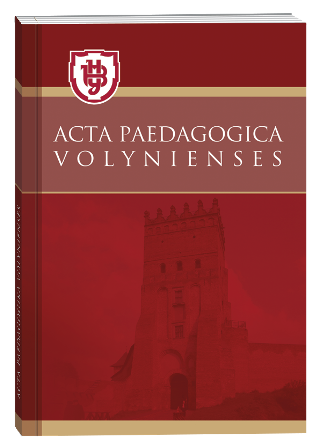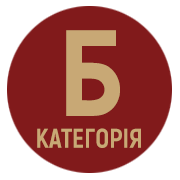DEVELOPMENT OF CREATIVE THINKING IN ENGLISH LANGUAGE LESSONS AT PRIMARY SCHOOL LEVEL IN CHILDREN WITH ASD
DOI:
https://doi.org/10.32782/apv/2021.5.13Keywords:
creative thinking, English language, autism, primary school, new Ukrainian school, communicative competenceAbstract
At present, Ukraine faces the problem of training foreign language teachers capable of working in an inclusive learning environment due to the growing number of students with special educational needs in general secondary educational institutions. Among them, cases of autism spectrum disorders prevail. According to the Concept of the New Ukrainian School, primary education involves the development in all students, without exception, of skills to communicate, interact with others using a foreign language orally, in writing and online, analyse and assimilate information to tackle various issues, acquire new knowledge and abilities, etc. Therefore, modern teachers are in constant search of effective teaching methods. According to the State Standard on Primary Education, creative thinking acts as an enhancing tool. In particular, in foreign language lessons, it is necessary to develop students' ability to think and create, using phonetic, lexical, grammatical skills, to conduct foreign language communication, consolidation of the previously studied material, expanding vocabulary. The analysis of educational and methodical literature shows that children with autism spectrum disorders are capable of creativity. However, teachers should take into account the specifics of their cognitive processes, focus on the abilities and talents of each child, on their strengths. The purpose of the article is to reveal the peculiarities of the development of creative thinking in foreign language lessons in children of primary school age with autism spectrum disorders. We used such research methods as theoretical analysis and generalization of literature sources to determine the theoretical foundations of this problem. The concept "creative thinking" is defined. The current study also describes performance on creativity tasks in children of primary school age with autism spectrum disorders, the effect creative activities have on the formation of foreign language communicative competence. Examples of learning activities that promote the development of creative thinking and the formation of communicative competence in foreign language lessons in an inclusive learning environment are given.
References
Абдуллаева М. Как сделать урок креативным. Вестник Таджикского государственного университета права, бизнеса и политики. Серия гуманитарных наук, 2014. № 5 (61). С. 294−299.
Алексеева М. Развитие творческого мышления младших школьников средствами арт-терапии (на материале обучения иностранному языку). : автореферат. Курск: Курский государственный университ, 2007. 27 с.
Будна Т. Б. Англійська мова. English : підручник для 2 кл. закладів загальн. серед. освіти (з аудіосупроводом). Тернопіль : Навчальна книга Богдан, 2019. 112 с.
Будна Т.Б. Англійська мова. English : підручник для 4 кл. закладів загальн. серед. освіти (з аудіосупроводом). Тернопіль : Навчальна книга Богдан, 2021. 120 с.
Державний Стандарт початкової освіти: постанова Кабінету Міністрів України від 21 лютого 2018 р. № 87. Київ, 2018. 37 с. URL : https://zakon.rada.gov.ua/laws/show/87-2018-%D0%BF#Text (дата звернення: 05.04.2021).
Павленко В. Розвиток креативності молодших школярів як педагогічна проблема. Проблеми освіти : Науково-методичний збірник. 2015. № 85. С. 152−158.
Савилова О. О креативном письме на занятиях по немецкому языку. Вестник Томского государственного университета. 2008. № 307. C. 143−144.
Сергєєва В. Застосування креативних методів навчання іноземної мови як засіб формування ціннісної сфери школярів. 2017. URL : http://nvd.luguniv.edu.ua/archiv/NN1/r3/07svetss.pdf. (дата звернення: 20.06. 2021)
Сіваченко О. Навчання аудіювання англомовних драматичних творів студентів старших курсів мовних спеціальностей : дис. … канд. пед. наук : 13.00.02. / Київський нац. лінгв. ун-т. Київ, 2009. 284 с.
Суровицька М. Вплив гри на розвиток особистості молодших школярів. Молодь і ринок. 2014. № 2. С. 170−174.
Чапюк Ю. Дидактичні умови розвитку креативного мислення молодших школярів у процесі навчання іноземних мов : дис. … канд. пед. наук : 13.00.09. / Тернопільський національний педагогічний університет імені Володимира Гнатюка. Тернопіль, 2018. 232 с.
Becker C., Roos J. An approach to creative speaking activities in the young learners’ classroom. Education Inquiry. 2016. № 7(1). Р. 9−26.
Craig J., Baron-Cohen S. Creativity and imagination in autism and Asperger syndrome. Journal of autism and developmental disorders. 1999. № 29(4). Р. 319−326.
Dziedziewicz D., Gajda A., Wołowicz-Ruszkowska A. Myślenie twórcze dzieci z zaburzeniami ze spektrum autyzmu. Człowiek – Niepełnosprawność – Społeczeństwo, Wydawnictwo Akademii Pedagogiki Specjalnej im. Marii Grzegorzewskiej. 2013. № 4(22). Р. 79−97.
Frith U. Cognitive mechanisms in autism: Experiments with colour and tone sequence production. Journal of Autism and Childhood Schizophrenia. 1972. № 2(2). Р. 160−173.
Gałązka A., Dick-Bursztyn M. Supporting English Language Teachers in Teaching Autistic Primary School Learners. The New Educational Review. 2019. Vol. 58. № 4. Р. 191−207.
Jen W. Researching creative writing. Suffolk: Frontinus Press, 2015. 271 р.
Liao Y. H., Chen Y. L., Chen H. C., Chang Y. L. Infusing creative pedagogy into an English as a foreign language classroom: Learning performance, creativity, and motivation. Thinking Skills and Creativity. 2018. № 29. Р. 213−223.
Padmadewi N., Artini L. Teaching English to a Student with Autism Spectrum Disorder in Regular Classroom in Indonesia. International Journal of Instruction. 2017. Vol. 10. № 3. Р. 159−176.
Smith A., Madden-Zibman E. Creativity in autism. Electronic edition. 2014. P. 243−258.
Yasemin B. The effect of critical reading skills on the evaluation skills of the creative reading process. Eurasian Journal of Educational Research. 2020. № 20(88). Р. 199−224.
Zafeiriadou N. Drama in language teaching. Issues. 2009. № 23. Р. 4−9.







